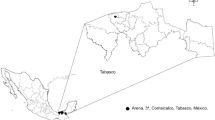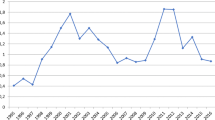Abstract
Rickettsiae, obligate intracellular Gram-negative bacteria, responsible for mild to severe diseases in humans are associated with arthropod vectors. Dermacentor marginatus and Dermacentor reticulatus are known vectors of Rickettsia slovaca and Rickettsia raoultii distributed across Europe. A total of 794 D. marginatus, D. reticulatus and Ixodes ricinus adult ticks were collected from the vegetation, removed from horses, sheep, goats and dogs in Slovakia. The DNA of Rickettsia sp. was found in 229 ticks by PCR amplifying parts of gltA, ompA and sca4 genes. Next analyses of Rickettsia-positive samples by PCR–RFLP and/or sequencing showed D. reticulatus ticks were more infected with R. raoultii and D. marginatus were more infected with R. slovaca. The prevalence of R. raoultii was 8.1–8.6% and 22.3–27% in D. marginatus and D. reticulatus, respectively. The prevalence of R. slovaca was 20.6–24.3% in D. marginatus and 1.7–3.4% in D. reticulatus. Intracellular growth of R. raoultii isolate from D. marginatus tick was evaluated by rOmpA-based quantitative SybrGreen PCR assay. The highest point of multiplication was recorded on the 7th and 8th day postinfection in Vero and L929 cells, respectively. R. raoultii was transmitted during feeding of R. raoultii-positive ticks to guinea pigs and subsequently rickettsial infection was recorded in all organs, the highest infection was in spleen, liver and heart. Our study describes the detection and isolation of tick-borne pathogens R. raoultii and R. slovaca, show that they are spread in Slovakia and highlight their risk for humans.



Similar content being viewed by others
References
Bekker CPJ, de Vos S, Taoufik A, Sparagano OAE, Jongejan F (2002) Simultaneous detection of Anaplasma and Ehrlichia species in ruminants and detection of Ehrlichia ruminantium in Amblyomma variegatum ticks by reverse line blot hybridization. Vet Microbiol 89:223–238
Boldiš V, Špitalská E (2010) Dermacentor marginatus and Ixodes ricinus ticks versus L929 and Vero cell lines in Rickettsia slovaca life cycle evaluated by quantitative real time PCR. Exp Appl Acarol 50:353–359. doi:10.1007/s10493-009-9322-7
Boldiš V, Kocianová E, Štrus J, Tušek-Žnidarič M, Sparagano OAE, Štefanidesová K, Špitalská E (2008) Rickettsial agents in Slovakian ticks (Acarina, Ixodidae) and their ability to grow in Vero and L929 cell lines. Ann NY Acad Sci 1149:281–285
Brezina R, Řeháček J, Áč P, Majerská M (1969) Two strains of rickettsiae of Rocky Mountain SFG recovered from D. marginatus ticks in Czechoslovakia. Results of preliminary serological identification. Acta Virol 13:142–145
Burgdorfer W (1970) Hemolymph test: a technique for detection of rickettsiae in ticks. Am J Trop Med Hyg 19:1010–1014
Chmielewski T, Podsiadly E, Karbowiak G, Tylewska-Wierzbanowska S (2009) Rickettsia spp. in ticks, Poland. Emerg Infect Dis 15:486–488. doi:10.3201/eid1503.080711
Dautela H, Dippela C, Oehmeb R, Harteltb K, Schettler E (2006) Evidence for an increased geographical distribution of Dermacentor reticulatus in Germany and detection of Rickettsia sp. RpA4. Int J Med Microbiol 296 (S1):149–156
Márquez FJ (2008) Spotted fever group Rickettsia in ticks from southeastern Spain natural parks. Exp Appl Acarol 45:185–194. doi:10.1007/s10493-008-9181-7
Márquez FJ, Rojas A, Ibarra V, Cantero A, Rojas J, Oteo JA, Muniain MA (2006) Prevalence data of Rickettsia slovaca and other SFG Rickettsiae species in Dermacentor marginatus in the southeastern Iberian Peninsula. Ann NY Acad Sci 1078:328–330
Mediannikov O, Matsumoto K, Samoylenko I, Drancourt M, Roux V, Rydkina E, Davoust B, Tarasevich I, Brouqui P, Fournier PE (2008) Rickettsia raoultii sp. nov., a new spotted fever group rickettsia associated with Dermacentor ticks in Europe and Russia. Int J Syst Evol Microbiol 58:1635–1639. doi:10.1099/ijs.0.64952-0
Milhano N, de Carvalho IL, Alves AS, Arroube S, Soares J, Rodriguez P, Carolino M, Núncio MS, Piesman J, de Sousa R (2010) Coinfections of Rickettsia slovaca and Rickettsia helvetica with Borrelia lusitaniae in ticks collected in a Safari Park, Portugal. Ticks Tick Borne Dis 1:172–177
Niebylski ML, Peacock MG, Schwan TG (1999) Lethal effect of Rickettsia rickettsii on its tick vector (Dermacentor andersoni). Appl Envirol Microbiol 65:773–778
Nijhof AM, Bodaan Ch, Postigo M, Nieuwenhuijs H, Opsteegh M, Franssen L, Jebbink F, Jongejan F (2007) Ticks and associated pathogens collected from domestic animals in the Netherlands. Vector Borne Zoonotic Dis 7:585–596. doi:10.1089/vbz.2007.0130
Parola P, Rovery C, Rolain JM, Brouqui P, Davoust B, Raoult D (2009) Rickettsia slovaca and R. raoultii in Tick-borne Rickettsioses. Emerg Infect Dis 15:1105–1108
Raoult D, Roux V (1997) Rickettsioses as paradigms of new or emerging infectious diseases. Clin Microbiol Rev 10:694–719
Raoult D, Berbis P, Roux V, Xu W, Maurin M (1997) A new tick-transmitted disease due to Rickettsia slovaca. Lancet 350:112–113. doi:10.1016/S0140-6736(05)61814-4
Regnery RL, Spruill CL, Plikaytis BD (1991) Genotypic identification of rickettsiae and estimation of intraspecies sequence divergence for portions of two rickettsial genes. J Bacteriol 173:1576–1589
Řeháček J, Úrvölgyi J, Kocianová E, Sekeyová Z, Vavreková M, Kováčova E (1991) Extensive examination of different tick species for infestation with Coxiella burnetii in Slovakia. Eur J Epidemiol 7:299–303
Roux V, Fournier PE, Raoult D (1996) Differentiation of spotted fever group rickettsiae by sequencing and analysis of restriction fragment length polymorphism of PCR amplified DNA of the gene encoding the protein rOmpA. J Clin Microbiol 34:2058–2065
Rydkina E, Roux V, Rudakov N, Gafarova M, Tarasevich I et al (1999) New Rickettsiae in ticks collected in territories of the former Soviet Union. Emerg Infect Dis 5:811–814
Selmi M, Martello E, Bertolotti L, Bisanzio D, Tomassone L (2009) Rickettsia slovaca and Rickettsia raoultii in Dermacentor marginatus ticks collected on wild boards in Tuscany, Italy. J Med Entomol 46:1490–1493
Shpynov S, Parola P, Rudakov N, Samoilenko I, Tankibaev M, Tarasevich I, Raoult D (2001) Detection and identification of spotted fever group rickettsiae in Dermacentor ticks from Russia and central Kazakhstan. Eur J Clin Microbiol Infect Dis 20:903–905
Socolovschi C, Mediannikov O, Raoult D, Parola P (2009) The relationship between spotted fever group Rickettsiae and Ixodid ticks. Vet Res 40:34. doi:10.1051/vetres/2009017
Špitalská E, Štefanidesová K, Kocianová E, Boldiš V (2008) Specific detection of Rickettsia slovaca by restriction fragment length polymorphism of sca4 gene. Acta Virol 52:189–191
Tamura K, Peterson D, Peterson N, Stecher G, Nei M, Kumar S (2011) MEGA5: molecular evolutionary genetics analysis using maximum likelihood, evolutionary distance, and maximum parsimony methods. Mol Biol Evol. doi:10.1093/molbev/msr121
Tijsse-Klasen E, Jameson LJ, Fonville M, Leach S, Sprong H, Medlock JM (2011) First detection of spotted fever group rickettsiae in Ixodes ricinus and Dermacentor reticulatus ticks in the UK. Epidemiol Infect 139:524–529
Vitorino L, De Sousa R, Bacellar F, Zé-Zé L (2007) Rickettsia sp. strain RpA4 detected in Portuguese Dermacentor marginatus ticks. Vector Borne Zoonotic Dis 7:217–220. doi:10.1089/vbz.2006.0603
Wilson K (1995) Preparation of genomic DNA from bacteria. In: Ausubel MF, Brent R, Kingston RE, Moore DD, Seidman JG, Smith JA, Struhl K (eds) Current protocols in molecular biology. Wiley, New York, pp 2.4.1–2.4.5
Acknowledgments
The study was financially supported by the grants VEGA Nos. 2/0065/09, 2/0142/10 and 2/0031/11 from the Scientific Grant Agency of Ministry of Education of Slovak Republic. We thank to Marianna Pjechová and Veronika Balážová for collection of samples and excellent technical assistance.
Author information
Authors and Affiliations
Corresponding author
Rights and permissions
About this article
Cite this article
Špitalská, E., Štefanidesová, K., Kocianová, E. et al. Rickettsia slovaca and Rickettsia raoultii in Dermacentor marginatus and Dermacentor reticulatus ticks from Slovak Republic. Exp Appl Acarol 57, 189–197 (2012). https://doi.org/10.1007/s10493-012-9539-8
Received:
Accepted:
Published:
Issue Date:
DOI: https://doi.org/10.1007/s10493-012-9539-8




